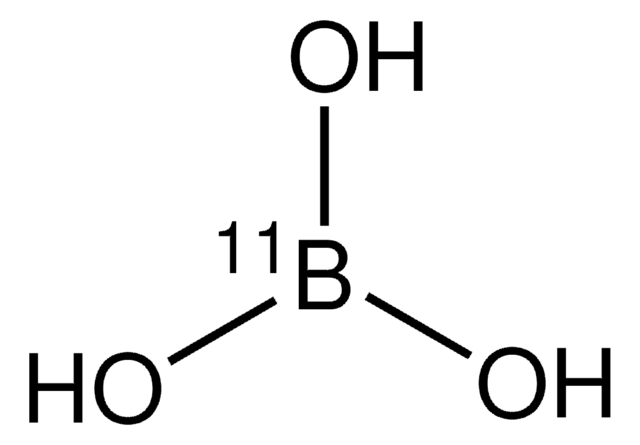Kluczowe dokumenty
About This Item
Polecane produkty
klasa czystości
reagent
Poziom jakości
agency
suitable for SM 4500 - NH3
suitable for SM 5210
ciśnienie pary
2.6 mmHg ( 20 °C)
linia produktu
ReagentPlus®
Próba
≥99.5%
Formularz
powder
mp
160 °C (dec.) (lit.)
rozpuszczalność
water: 40 mg/mL, clear, colorless
gęstość
1.440 g/cm3
ciąg SMILES
OB(O)O
InChI
1S/BH3O3/c2-1(3)4/h2-4H
Klucz InChI
KGBXLFKZBHKPEV-UHFFFAOYSA-N
Szukasz podobnych produktów? Odwiedź Przewodnik dotyczący porównywania produktów
Opis ogólny
Zastosowanie
- A catalyst to synthesize poly(δ-valerolactone) via bulk-ring opening polymerization.
- A ligand to synthesize metal-organic frameworks.
- A reagent in the preparation of borate buffer.
- A crosslinker to electrospun dextran nanofibers.
Informacje prawne
Hasło ostrzegawcze
Danger
Zwroty wskazujące rodzaj zagrożenia
Zwroty wskazujące środki ostrożności
Klasyfikacja zagrożeń
Repr. 1B
Kod klasy składowania
6.1D - Non-combustible acute toxic Cat.3 / toxic hazardous materials or hazardous materials causing chronic effects
Klasa zagrożenia wodnego (WGK)
WGK 1
Temperatura zapłonu (°F)
Not applicable
Temperatura zapłonu (°C)
Not applicable
Wykazy regulacyjne
Wykazy regulacyjne dotyczą głównie produktów chemicznych. Można w nich podawać ograniczoną liczbę informacji na temat produktów niechemicznych. Brak wpisu oznacza, że żaden ze składników nie znajduje się w wykazie. Użytkownik odpowiada za zagwarantowanie bezpiecznego i zgodnego z prawem stosowania produktu.
EU REACH SVHC Candidate List
EU REACH Annex XVII (Restriction List)
Wybierz jedną z najnowszych wersji:
Masz już ten produkt?
Dokumenty związane z niedawno zakupionymi produktami zostały zamieszczone w Bibliotece dokumentów.
Klienci oglądali również te produkty
Nasz zespół naukowców ma doświadczenie we wszystkich obszarach badań, w tym w naukach przyrodniczych, materiałoznawstwie, syntezie chemicznej, chromatografii, analityce i wielu innych dziedzinach.
Skontaktuj się z zespołem ds. pomocy technicznej



